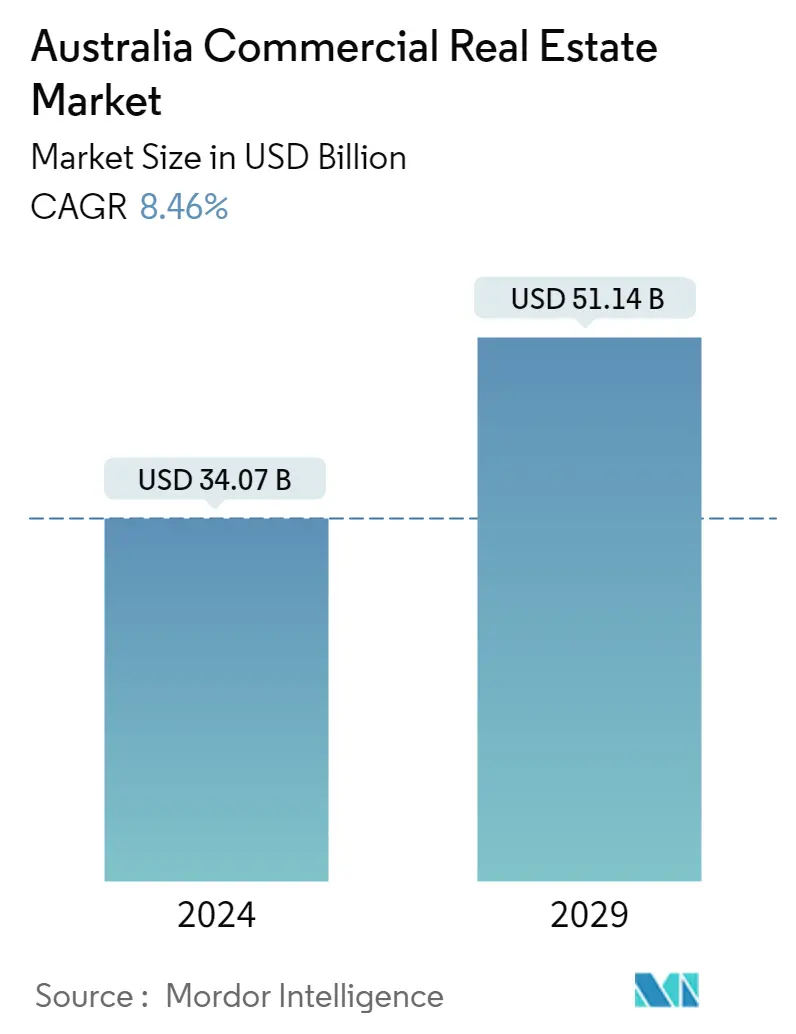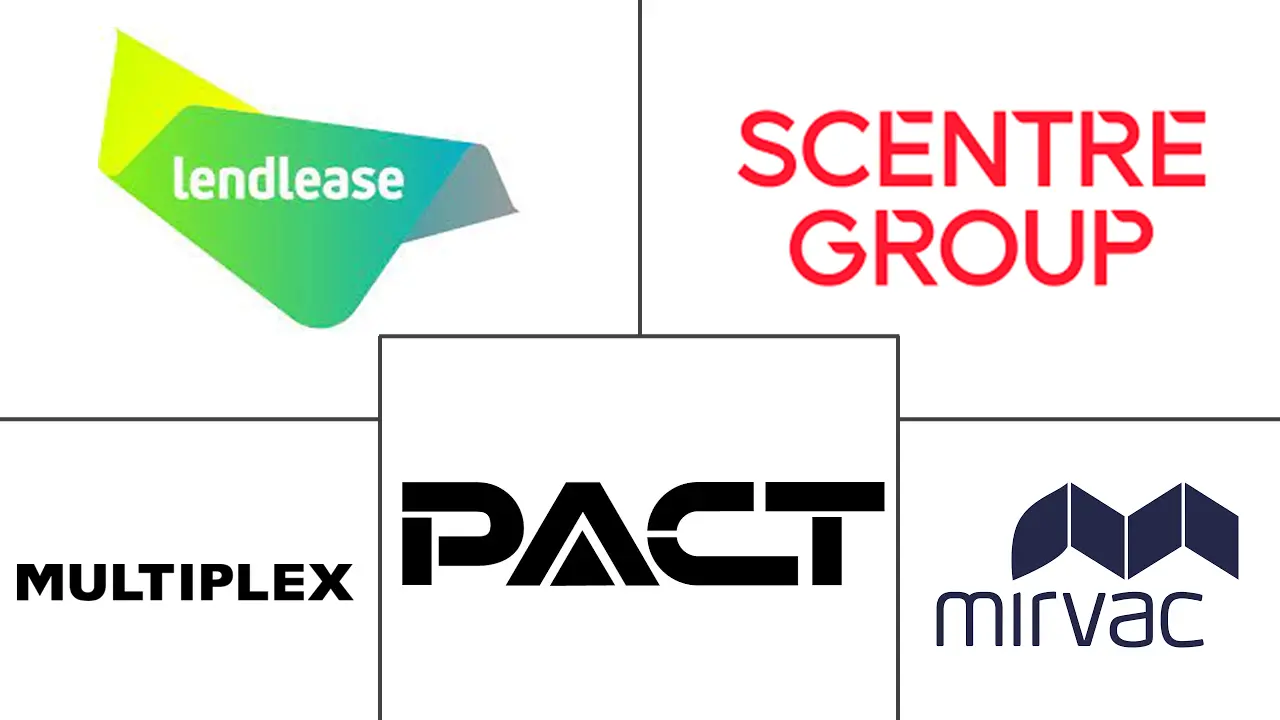Market Size of Australia Commercial Real Estate Industry

| Study Period | 2020 - 2029 |
| Base Year For Estimation | 2023 |
| Market Size (2024) | USD 34.07 Billion |
| Market Size (2029) | USD 51.14 Billion |
| CAGR (2024 - 2029) | 8.46 % |
| Market Concentration | Low |
Major Players
*Disclaimer: Major Players sorted in no particular order |
Australia Commercial Real Estate Market Analysis
The Australia Commercial Real Estate Market size is estimated at USD 34.07 billion in 2024, and is expected to reach USD 51.14 billion by 2029, growing at a CAGR of 8.46% during the forecast period (2024-2029).
• Australia's commercial real estate market has flourished in recent years, spearheaded by prominent cities such as Sydney and Melbourne. These cities have witnessed robust demand for office spaces, retail properties, and industrial facilities.
• Australian commercial property sales in the third quarter of 2023 decreased by 58% to AUD 4.0 billion (USD 2.60 billion), compared to AUD 9.6 billion (USD 6.24 billion) for the third quarter of 2022.
• Sales in the office, logistics, industrial, and retail sectors decreased by 77%, 38%, and 29%, respectively, from AUD 1.2 billion (USD 0.78 billion) in office volumes in Q3 2023 to AUD 1.6 billion (USD 1.04 billion) in L&I volumes in Q3 2022, while logistics & industrial volumes decreased by 38% and retail volumes decreased by 29% compared to Q3 2022.
• Year-on-year (YoY) transaction volume in the first nine months of 2023 totaled AUD 11.8 billion (USD 7.67 billion), as compared to AUD 29.2 billion (USD 18.97 billion) in the full calendar year 2022.
• All commercial property transactions across all sectors (office, retail, logistics & industrial) showed a slight increase in volume in Q3 2023. The Q3 2023 office volumes increased 106% year-on-year (YoY) from USD 594 million in the June quarter (to USD 1.2 Billion) to USD 1.3 Billion in the September quarter (to Q4 2022).
• The biggest Q3 sales across all sectors were the USD 560 million sale of 20 prime industrial assets (50% interest) to UniSuper. Other notable sales included USD 465 million for Midland Gate Shopping Centre (WA), USD 313 million for 7 Spencer Street (Vic), USD 393.1 million for 44 Market Street (NSW), USD 296 Million for 1 Margaret Street (NSW), and USD 200 million for 189 kent street (NSW).
Australia Commercial Real Estate Industry Segmentation
Commercial real estate (CRE) is a property used exclusively for business or workplace purposes or to generate cash flow in some way for the owner or lessee.
Australia's commercial real estate market is segmented by type (office, retail, industrial and logistics, hospitality, and others) and by key cities (Sydney, Melbourne, Brisbane, Adelaide, Canberra, and Perth).
The report offers market size and forecasts for the Australian commercial real estate market in terms of value (USD) for all the above segments.
| By Type | |
| Office | |
| Retail | |
| Industrial and Logistics | |
| Hospitality | |
| Other Types |
| By City | |
| Sydney | |
| Melbourne | |
| Brisbane | |
| Adelaide | |
| Canberra | |
| Perth |
Australia Commercial Real Estate Market Size Summary
The Australian commercial property market is experiencing significant growth, driven by strong demand in major cities like Sydney and Melbourne. This sector has seen a robust increase in office spaces, retail properties, and industrial facilities, making it an attractive destination for global institutional investors. Despite a recent decline in property sales across various sectors, including office, logistics, industrial, and retail, the market remains competitive and resilient. The national retail leasing market has shown stability, with established retailers expanding their presence in prime locations, such as Adelaide's CBD. Development projects, like the District Outlet Centre in Parafield, highlight ongoing investment in the sector, with average rents remaining stable and showing growth in large-format retail subsectors.
The commercial real estate landscape in Australia is characterized by the presence of major players such as Lendlease Corporation, Scentre Group Limited, and Mirvac, among others. These companies are actively involved in significant developments, including Costco's expansion plans and Lendlease's Build-to-Rent projects in Melbourne and Brisbane. The market's appeal is further enhanced by declining vacancy levels and rising rental rates, attracting both small-scale and large-scale developers. Despite challenges such as negative net absorption in certain areas and increasing vacancy rates in secondary grades, the overall outlook for the Australian commercial property market remains positive, with continued interest from investors and developers alike.
Australia Commercial Real Estate Market Size - Table of Contents
-
1. MARKET DYNAMICS
-
1.1 Drivers
-
1.1.1 Rapid Urbanization
-
1.1.2 Government Initiatives Actively promoting the Construction Activities
-
-
1.2 Restraints
-
1.2.1 Shortage of Skilled Labor
-
1.2.2 Supply chain issues and rising material costs
-
-
1.3 Opportunities
-
1.3.1 Technological Innovations
-
-
1.4 Value Chain / Supply Chain Analysis
-
1.5 Industry Attractiveness - Porter's Five Forces Analysis
-
1.5.1 Bargaining Power of Suppliers
-
1.5.2 Bargaining Power of Buyers/Consumers
-
1.5.3 Threat of New Entrants
-
1.5.4 Threat of Substitute Products
-
1.5.5 Intensity of Competitive Rivalry
-
-
-
2. MARKET SEGMENTATION
-
2.1 By Type
-
2.1.1 Office
-
2.1.2 Retail
-
2.1.3 Industrial and Logistics
-
2.1.4 Hospitality
-
2.1.5 Other Types
-
-
2.2 By City
-
2.2.1 Sydney
-
2.2.2 Melbourne
-
2.2.3 Brisbane
-
2.2.4 Adelaide
-
2.2.5 Canberra
-
2.2.6 Perth
-
-
Australia Commercial Real Estate Market Size FAQs
How big is the Australia Commercial Real Estate Market?
The Australia Commercial Real Estate Market size is expected to reach USD 34.07 billion in 2024 and grow at a CAGR of 8.46% to reach USD 51.14 billion by 2029.
What is the current Australia Commercial Real Estate Market size?
In 2024, the Australia Commercial Real Estate Market size is expected to reach USD 34.07 billion.

